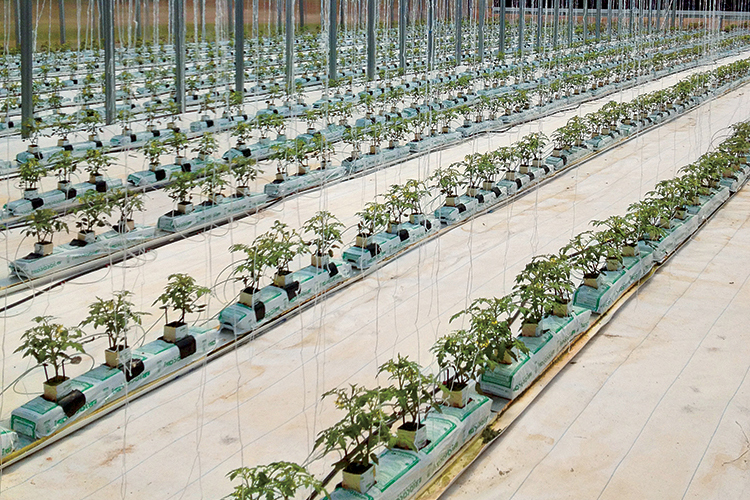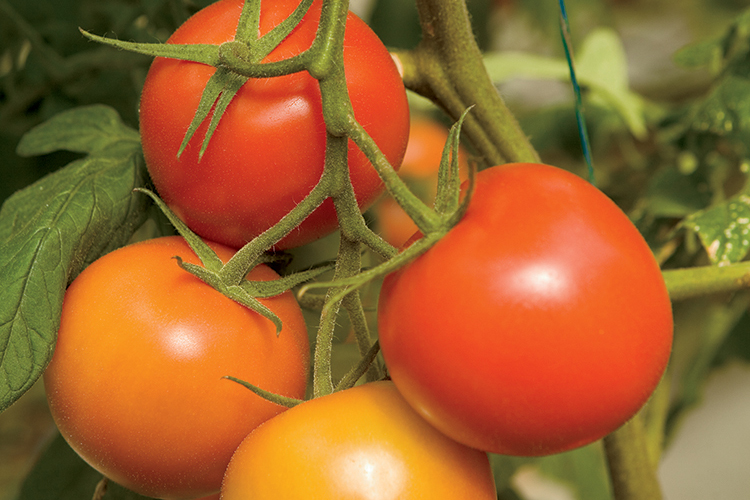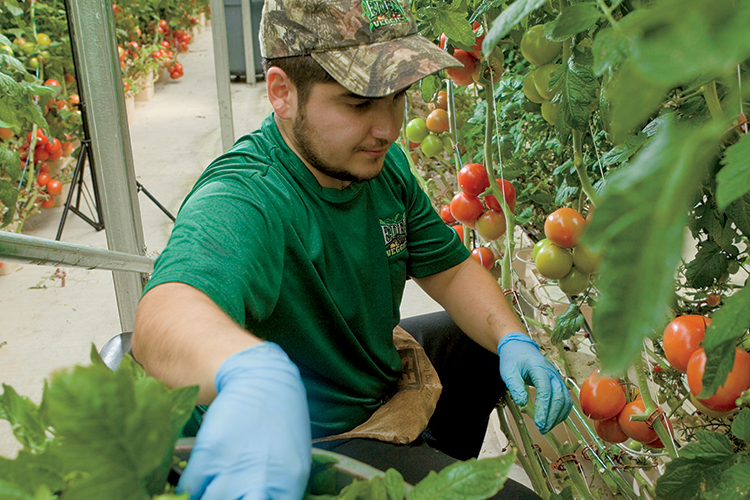Home > Oklahoma > Oklahoma Crops & Livestock > Oklahoma Tomato Industry is Vine-Ripe
Oklahoma Tomato Industry is Vine-Ripe

Cheryl Stinchcomb grew up eating fresh tomatoes from her father’s garden. Picked off the vine just moments before being sliced is the best way to enjoy the vegetable, she says. Stinchcomb found it nearly impossible to craft the perfect BLT sandwich because she could never find the perfect tomato.
“I’ve heard the complaint from more than one person,” Stinchcomb says. “They couldn’t find good garden-fresh produce in their local grocery stores.”
Her passion for homegrown produce – instilled in her by her father at a young age – was the inspiration for Eden Veggies, a Broken Arrow-based greenhouse that grows full-flavor, nutrient-rich, high-quality red tomatoes, heirloom tomatoes, herbs and cucumbers. Her 12,000-square-foot indoor garden produces 60,000 to 70,000 pounds of tomatoes each year and uses hydroponics and bumblebees to pollinate the plants. All plants are free of herbicides and pesticides.
“This was something that was very important to me,” she says. “I wanted to create a quality product that was fresh, locally grown and healthy.”
Josh Thomas grew up around the fresh wholesale produce business and became interested in greenhouse hydroponics in 2012. The following year, Josh harvested his first crop of hydroponic tomatoes at his small farm in Yukon. His tomatoes are sold in grocery stores in the region, including Whole Foods.
“I have a 3-year-old daughter and 1-year-old son, and I feel it is important for them to learn how to grow their food,” Josh says.

A Growing Industry
The produce industry is growing in Oklahoma. Last year, vegetable crops in the state contributed $19.3 million. Of the acres of produce harvested, 229 acres were tomato plants, the majority of which were for fresh market sales, says Dr. Lynn Brandenberger, vegetable professor at Oklahoma State University.
Based on the lowest average yields, Brandenberger estimates 7,136 pounds of tomatoes were harvested per acre in 2013. At the United States Department of Agriculture’s $2.94 per pound price, that is nearly $21,000 per acre of tomatoes.
“With those numbers, you can see why the tomato is a popular vegetable with the fresh market farms,” he says.
Identifying the Market
The vegetable’s growing popularity means a higher demand from farmers and improving the way they reach customers across the state. Farmers are increasing their product availability by pursuing different marketing channels, Brandenberger says. Selling at farmers markets, using Community Supported Agriculture (CSA) systems, direct sales to schools and restaurants, and on-farm direct sales are among these efforts.
“Fresh produce farmers understand that they are growing a perishable product and because of this, they work on marketing their crops on a year-round basis.”
Eden Veggies supplies vine-ripe tomatoes to local grocery stores, including Reasor’s, and farmers markets, and the business has a partnership with the local school systems including Tulsa Union School District and Broken Arrow schools to provide fresh tomatoes for student lunches.
“We deliver the tomatoes directly to each school within 48 hours of picking,” Stinchcomb says. “People want vegetables fresh, and we’re providing that.”

Keeping it Local
While Eden Veggies slowly expands to accommodate its local customers, Stinchcomb is adamant about keeping her business within the Tulsa community.
“The local community is very important to us. We want to be able to pick our tomatoes and have them in the hands of consumers within 48 hours to ensure they’re getting the best tomato we can provide.”
This farm-to-table approach is important to the customer as well. The desire to eat local is growing in homes across the country, Oklahoma included.
“Consumers are beginning to understand the importance of locally grown products,” Brandenberger says. “In general, around urban areas of the state, consumers are seeking out locally grown sources of food to support local farmers and because they understand that there are some inherent risks involved with relying totally on food sources that are on the other side of the country or even the world.”
“It’s about having a safe product to feed your family,” Stinchcomb agrees. “It is more and more important for families to know where their food comes from, who is growing it and how they are growing it.”



